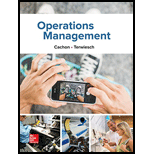
Concept explainers
CASE WARKWORTH FURNITURE1
Warkworth Furniture specializes in environmentally friendly and sustainable furniture. One of its products, the TePaki desk, uses bamboo for the surface and recycled aluminum for the supports. The desk is made in its factory in Vietnam and shipped to all of its 30 stores throughout the United States, primarily in the large urban areas on either coast. Karen Williamson, the owner of Warkworth Furniture, is struggling with how it should organize its supply chain.
Currently, it ships the desks from Vietnam to the United States via ocean carrier. Once they arrive in the United States, they are shipped via a third-party carrier to each store. It usually takes 10 weeks between when an order is placed with the factory and when the product is received in a store.
The TePaki desk may be eco-friendly, but it isn’t wallet friendly: Each desk costs Warkworth $325 to make and it sells the desk for $850. Nevertheless, Warkworth has been able to identify a market segment of customers that value the look of the desk and what it represents. Across its stores, it sells six desks per week, or 0.2 desk per week per store.
Given the upscale nature of its business, Warkworth’s stores are located in nice areas that unfortunately have high rents. Consequently, between the opportunity cost of capital and the cost of physical space, Karen estimates that it costs Warkworth $150 to hold each TePaki desk in one of its stores for one year. It would be a financial disaster if each desk actually spent the entire year in inventory in a store, but the $150 does represent the true cost of holding a desk in a store for that period of time.
Shipping a TePaki desk from Vietnam to a store costs Warkworth $80 per desk, about $40 for the ocean portion of the journey and $40 for the land portion within the United States.
Andy Philpot, Warkworth’s director of operations, has been arguing for some time that Warkworth should set up a distribution center in southern California to receive products from Asia, and from there distribute them to its various stores. Warehouse space is much cheaper than prime retail space. Hence, the holding cost per TePaki desk per year in a warehouse would only be $60. The only problem with this approach, according to Andy, is that the total shipping cost from factory to store could increase by $8 per desk due to the extra handling and shipping distance once all of the desks are routed through a distribution center.
Karen understands why the distribution center approach could make sense, but she worries about getting all of the execution done right. Instead, she suggests that it ship all of the desks directly to the stores as it currently does, but then ship product between stores as needed. The only problem with that approach is that it probably will cost it about $40 per desk to ship from one store to another.

To add to the discussion, Kathy White, Warkworth’s marketing director, is concerned with how these ideas will affect the desks’ instore availability. She proudly reminds everyone that Warkworth currently has a .99 in-stock probability for the TePaki desk. Andy, a typical ops guy, quips that it could save a ton if it were willing to make its customers wait a week or so to get their desk delivered to the store from a distribution center.
Would you recommend that it consider Karen’s idea of holding all inventory at the stores but shipping between stores as needed?
Want to see the full answer?
Check out a sample textbook solution
Chapter 14 Solutions
Operations Management
- Can you guys help me with this? Thank you! Here's the question: Compared to the CONSTRAINT model, how has the network changed? How do you plan to add contingency to your network? Please answer this throughly Here's the what-if scenario: Assume that Dallas plant has lost power. It cannot serve the DCs anymore and has to remain locked indefinitely. Re-optimize the network considering this new constraint. Here's the scenario comparison analysis: Scenario Constraint Scenario vs What-if Scenario Summary In comparing the Constraint Scenario to the What-if Scenario, a few key differences highlight the efficiencies evident in the supply chain. Firstly, the total cost in the Constraint Scenario is lower at $7,424,575.45, while the What-if Scenario incurs a total cost of $7,486,369.12, resulting in a cost delta of $61,793.67. Additionally, although both scenarios exhibit the same average service time of 0.72 days, the What-if Scenario has a more favorable average end-to-end service time of 2.41…arrow_forwardEmployee In-Service Training ASSIGNMENT: In-Service Training. The intern is required to plan and implement two in-service training sessions for employees. Each in-service should last at least 10 but not more than 30 minutes and should be given to all employees affected. The preceptor or supervisor/unit manager must approve all in-service topics. 1) One presentation should be related to a policy or procedure of any kind (e.g. proper use of equipment); 2) The second presentation must be related to sanitation or safety. For each in-service presentation, the intern must develop a written class plan and a visual aid (may be a handout, poster, PowerPoint slide presentation, etc.) appropriate to the life experiences, cultural diversity and educational background of the target audience. The intern must also measure behavior change. Note, this cannot be measured by a written pre- and post- test. That would be measuring knowledge. The intern mustactually observe and document that the learners…arrow_forwardFor a dietary manager in a nursing home to train a dietary aidearrow_forward
- Dietary Management in a Nursing Home. As detailed as possible.arrow_forwardFor dietary management in a nursing home. As detailed as possible.arrow_forwardA small furniture manufacturer produces tables and chairs. Each product must go through three stages of the manufacturing process – assembly, finishing, and inspection. Each table requires 3 hours of assembly, 2 hours of finishing, and 1 hour of inspection. The profit per table is $120 while the profit per chair is $80. Currently, each week there are 200 hours of assembly time available, 180 hours of finishing time, and 40 hours of inspection time. Linear programming is to be used to develop a production schedule. Define the variables as follows: T = number of tables produced each week C= number of chairs produced each week According to the above information, what would the objective function be? (a) Maximize T+C (b) Maximize 120T + 80C (c) Maximize 200T+200C (d) Minimize 6T+5C (e) none of the above According to the information provided in Question 17, which of the following would be a necessary constraint in the problem? (a) T+C ≤ 40 (b) T+C ≤ 200 (c) T+C ≤ 180 (d) 120T+80C ≥ 1000…arrow_forward
- As much detail as possible. Dietary Management- Nursing Home Don't add any fill-in-the-blanksarrow_forwardMenu Planning Instructions Use the following questions and points as a guide to completing this assignment. The report should be typed. Give a copy to the facility preceptor. Submit a copy in your Foodservice System Management weekly submission. 1. Are there any federal regulations and state statutes or rules with which they must comply? Ask preceptor about regulations that could prescribe a certain amount of food that must be kept on hand for emergencies, etc. Is the facility accredited by any agency such as Joint Commission? 2. Describe the kind of menu the facility uses (may include standard select menu, menu specific to station, non-select, select, room service, etc.) 3. What type of foodservice does the facility have? This could be various stations to choose from, self-serve, 4. conventional, cook-chill, assembly-serve, etc. Are there things about the facility or system that place a constraint on the menu to be served? Consider how patients/guests are served (e.g. do they serve…arrow_forwardWork with the chef and/or production manager to identify a menu item (or potential menu item) for which a standardized recipe is needed. Record the recipe with which you started and expand it to meet the number of servings required by the facility. Develop an evaluation rubric. Conduct an evaluation of the product. There should be three or more people evaluating the product for quality. Write a brief report of this activity • Product chosen and the reason why it was selected When and where the facility could use the product The standardized recipe sheet or card 。 o Use the facility's format or Design one of your own using a form of your choice; be sure to include the required elements • • Recipe title Yield and portion size Cooking time and temperature Ingredients and quantities Specify AP or EP Procedures (direction)arrow_forward
 Purchasing and Supply Chain ManagementOperations ManagementISBN:9781285869681Author:Robert M. Monczka, Robert B. Handfield, Larry C. Giunipero, James L. PattersonPublisher:Cengage Learning
Purchasing and Supply Chain ManagementOperations ManagementISBN:9781285869681Author:Robert M. Monczka, Robert B. Handfield, Larry C. Giunipero, James L. PattersonPublisher:Cengage Learning Practical Management ScienceOperations ManagementISBN:9781337406659Author:WINSTON, Wayne L.Publisher:Cengage,
Practical Management ScienceOperations ManagementISBN:9781337406659Author:WINSTON, Wayne L.Publisher:Cengage,- MarketingMarketingISBN:9780357033791Author:Pride, William MPublisher:South Western Educational Publishing
 Contemporary MarketingMarketingISBN:9780357033777Author:Louis E. Boone, David L. KurtzPublisher:Cengage Learning
Contemporary MarketingMarketingISBN:9780357033777Author:Louis E. Boone, David L. KurtzPublisher:Cengage Learning




